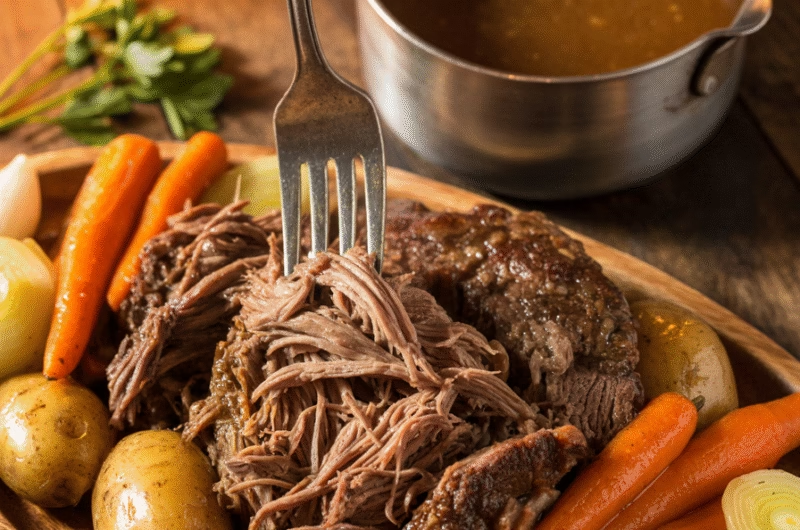The perfect slow cooker pot roast starts with a chuck roast, seared for flavor, cooked low and slow with potatoes, carrots, and onions in rich beef broth, then optionally finished with a thickened gravy for a hearty, fork-tender meal.
Why This Recipe Wins Every Time
The Magic of Low and Slow Cooking
Ever wonder why your pot roast turns out tough no matter what? Chances are, you’re rushing it. Low and slow is the only way to go if you want that melt-in-your-mouth texture. Cooking on low for 8–10 hours gives the collagen in the chuck roast time to break down into gelatin, which makes every bite unbelievably tender. I’ve tried high heat shortcuts—IMO, they’re just not worth it. Sure, you can cook it on high for 5–6 hours, but the meat won’t be nearly as fall-apart soft. So, unless you’re in a real hurry, set it and forget it on low. Your taste buds will thank you.
Choosing the Right Cut
Not all beef is created equal. For this recipe, chuck roast is your best friend. It’s well-marbled, which means all that fat melts into the meat during cooking, keeping it juicy and flavorful. It’s also budget-friendly, which is always a win in my book. I’ve seen people try sirloin or round—don’t do it. Those cuts are leaner and end up dry and stringy. Stick with chuck, and you’ll never look back.
The Ingredients You Need
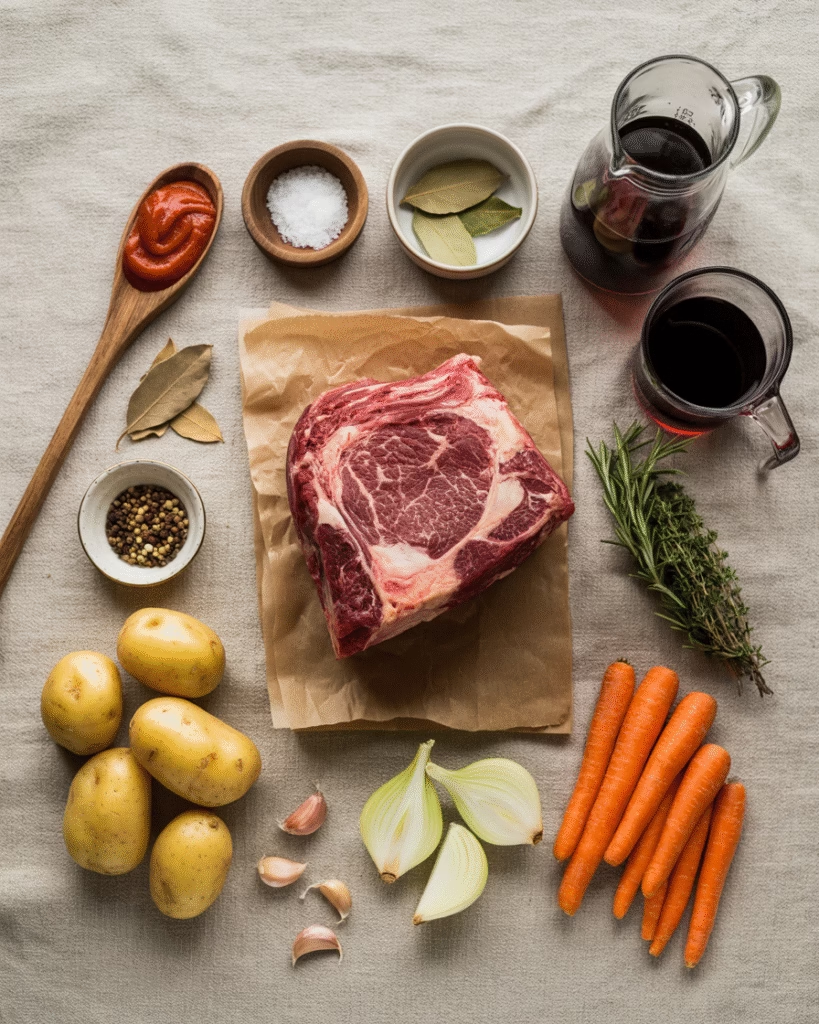
Core Components
- 4–5 lb chuck roast – Look for one with good marbling n- 2–3 cups low-sodium beef broth – Adds depth and moisture n- 1 large yellow onion, sliced – Sweetness and aroma basen- 1 lb carrots, peeled and cut into chunks – Classic comfort food veggie n- 24 oz baby potatoes or Yukon golds – Hearty and buttery n- 2 tsp olive or avocado oil – For searing n- 1 tsp salt, ½ tsp pepper, 1 tsp dried thyme – Simple seasoning that works n- 6–7 garlic cloves, minced – Because flavor matters
Optional Game-Changers
- 2 tbsp tomato paste – Adds richness and umami n- ½ cup dry red wine – Deepens the flavor (Pinot Noir or Merlot work great) n- 2 bay leaves – Subtle herbal note n- Worcestershire sauce (1–2 tsp) – Savory depth
Step-by-Step: How to Make It
Step 1: Sear the Meat (Don’t Skip This!)
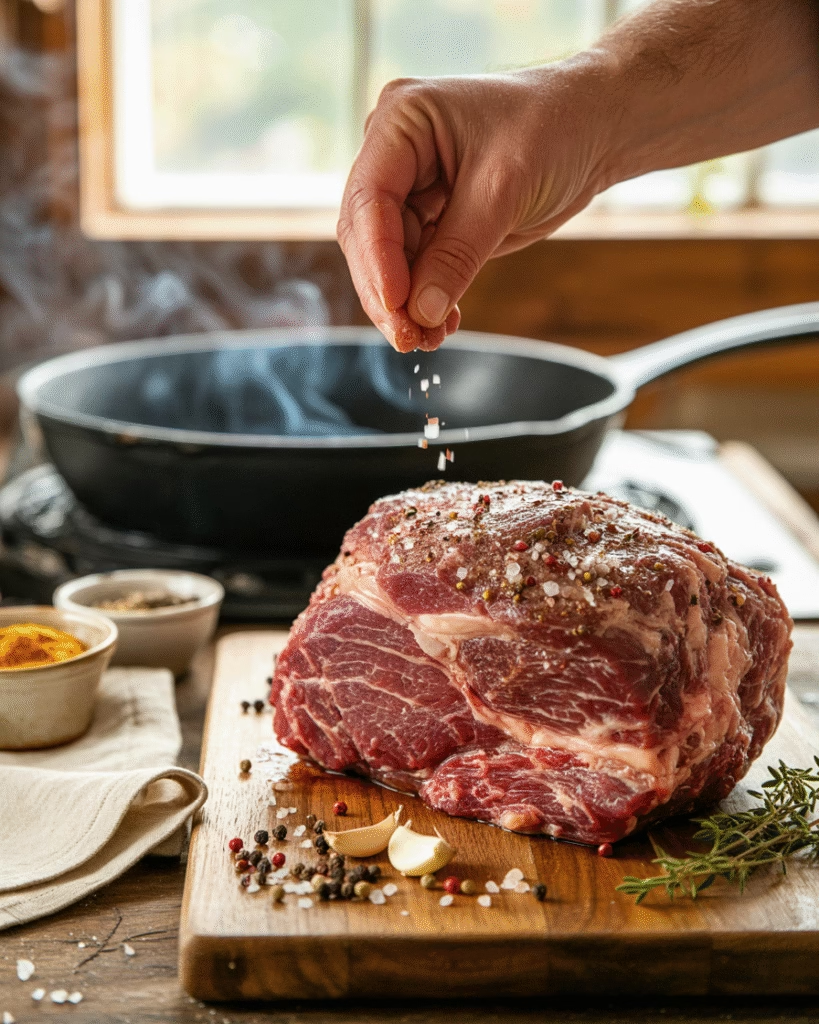
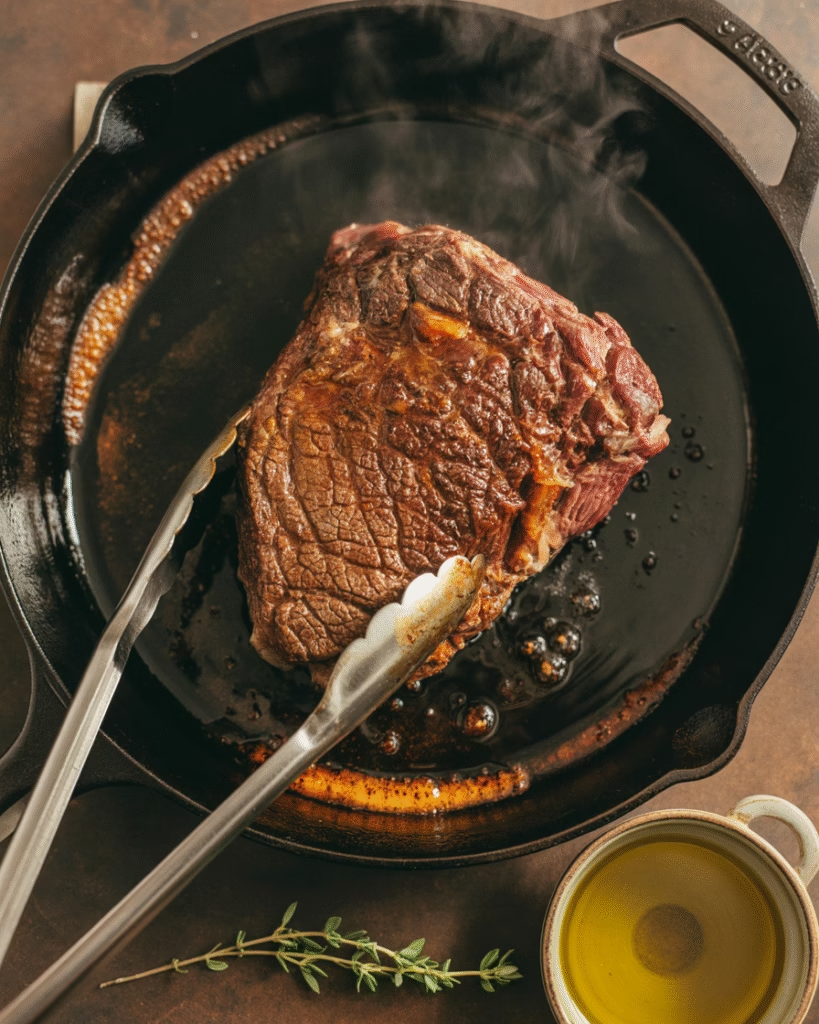
I get it—searing adds a few minutes. But FYI, that golden crust is where the flavor lives. Heat 2 tsp oil in a skillet over medium-high. Pat the roast dry (wet meat won’t brown), season it, and sear all sides for 3–4 minutes each. It should sound like sizzling bacon. Trust me, this step makes a difference. If you’re doing a “dump and go,” sure, skip it—but don’t expect restaurant-level results.
Step 2: Layer in the Slow Cooker
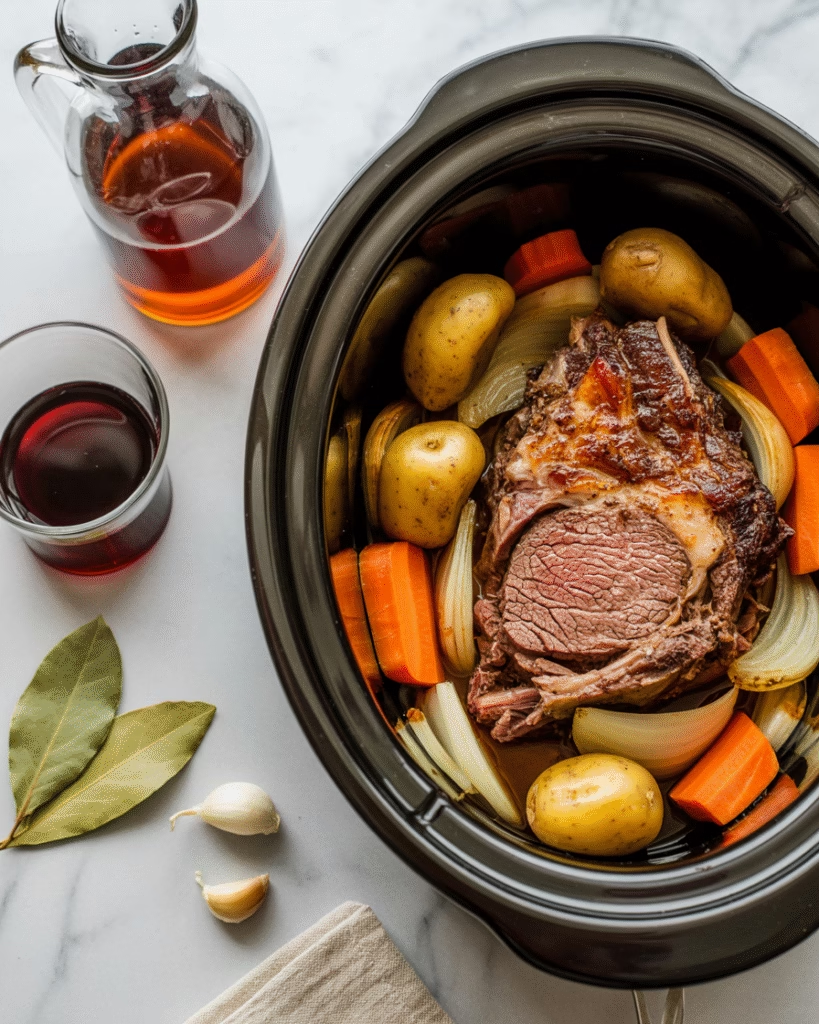
Start with onions at the bottom—they act as a flavor base and prevent sticking. Place the seared roast on top. Sprinkle with thyme, salt, pepper, and garlic. Add the potatoes and carrots around it. Pour in the broth (and wine, if using). If you’re adding tomato paste or Worcestershire, stir them into the liquid. No need to submerge everything—just enough to cover the bottom half of the veggies.
Step 3: Cook It Right
Cover and cook on low for 8–10 hours or high for 5–6 hours. After 6 hours on low, check if the meat shreds easily with a fork. If not, keep going. And don’t peek! Every time you lift the lid, you lose heat and extend cooking time. Just. Let. It. Be.
Step 4: Optional Gravy (Worth the Extra Effort)
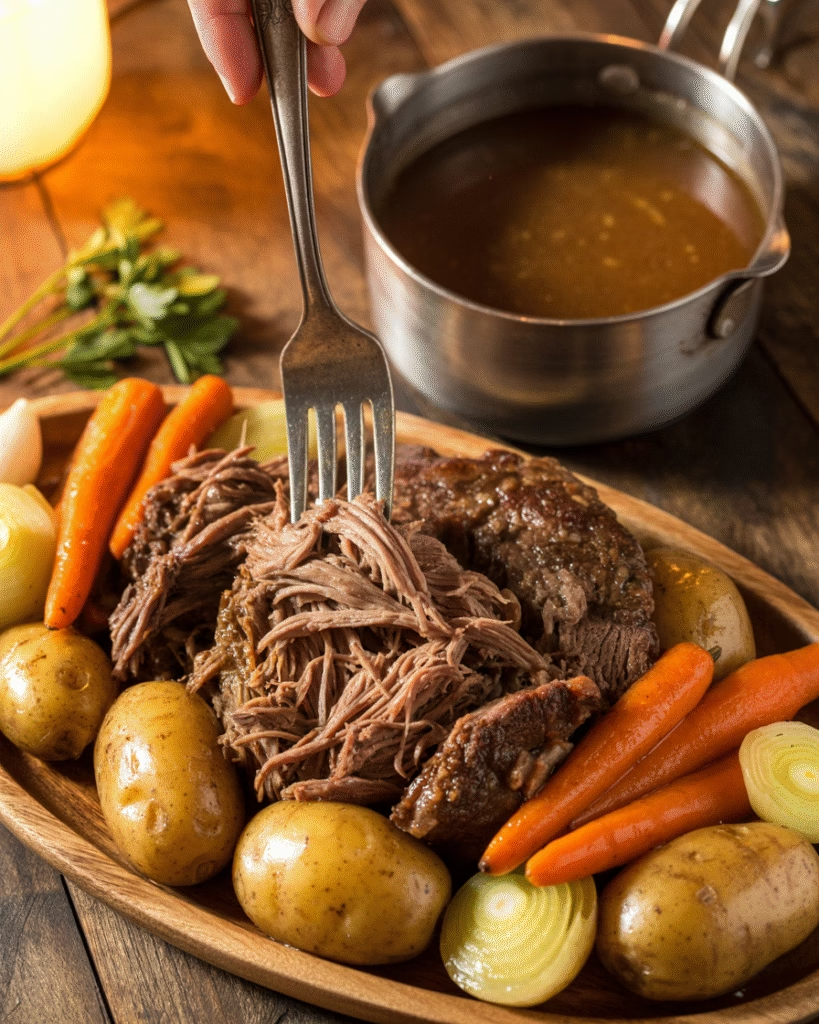
Here’s a pro tip: make your own gravy instead of using canned soup. Remove the meat and veggies, then strain 1½–2 cups of the cooking liquid into a saucepan. In a small bowl, mix 2 tbsp cornstarch with 3 tbsp cold water to make a slurry. Whisk it into the simmering liquid and cook for 2–3 minutes until thickened. Season with salt and pepper. Boom—silky, rich gravy that’s way better than the canned stuff.
Tips for Success
When to Add the Veggies
Add potatoes and carrots at the beginning if cooking on low. If you’re short on time and using high heat, add them after 4–5 hours so they don’t turn to mush. Nobody wants soggy carrots, right? 🙂
Can You Overcook It?
Funny you ask. I’ve left mine in for 12 hours—still great. But after 14? It started to dry out. So, yes, overcooking is possible. Stick to 8–10 hours on low for the sweet spot between tender and juicy.
Make It Ahead
This tastes even better the next day. Cook it, cool it, store it in the fridge (without the veggies if freezing), and reheat gently. Meal prep heaven.
Serving Suggestions
Serve the shredded beef with the veggies and a ladle of that homemade gravy. Pair it with:
- Mashed potatoes (duh) n- Steamed green beans or air fryer Brussels sprouts n- A simple side salad with vinaigrette
Leftovers? Toss the beef into tacos, shepherd’s pie, or beef stew. It’s versatile.
Storage and Reheating
Store in an airtight container in the fridge for up to 4 days. Freeze the meat and gravy (without veggies) for up to 3 months. Thaw overnight in the fridge and reheat on the stovetop or microwave.
Final Thoughts
This isn’t just another crockpot recipe—it’s comfort food at its finest. Simple ingredients, minimal prep, and maximum flavor. Whether you’re feeding a family of five or just want hearty leftovers, this slow cooker pot roast delivers every time. So, grab that chuck roast, sear it like you mean it, and let your slow cooker do the rest. You’ve got this.
Slow Cooker Pot Roast Recipe: Fall-Apart Tender, Big Sunday Flavor
Course: Main, DinnerCuisine: AmericanDifficulty: Easy6
servings15
minutes8
hours480
kcal8
hours30
minutesFork-tender chuck roast slow-cooked with potatoes, carrots, and onions in a rich beef broth, finished with an optional silky gravy. Simple prep, big cozy flavor, and perfect for make-ahead meals.
Ingredients
For the roast and vegetables:
3.5–4.5 lb chuck roast, well-marbled
2 teaspoons kosher salt
1 teaspoon freshly cracked black pepper
1 teaspoon dried thyme (or 3–4 sprigs fresh)
6–7 garlic cloves, minced
1 large yellow onion, sliced
1 lb carrots, peeled and cut into 2-inch chunks
1.5 lb baby potatoes or Yukon golds, halved if large
2 tablespoons olive oil or avocado oil (for searing)
2–3 cups low-sodium beef broth
- Optional flavor boosters:
2 tablespoons tomato paste
1/2 cup dry red wine (Pinot Noir or Merlot)
1–2 teaspoons Worcestershire sauce
2 bay leaves
- Optional gravy (stovetop):
2 tablespoons cornstarch
3 tablespoons cold water
Salt and pepper to taste
Directions
- Season and sear
Pat the chuck roast dry thoroughly.
Season all sides with salt, pepper, and dried thyme.
Heat oil in a cast-iron skillet over medium-high until shimmering.
Sear the roast 3–4 minutes per side until deep brown and crusty. Don’t rush the crust. - Build the slow cooker base
Place sliced onions in the bottom of the slow cooker.
Nestle the seared roast on top of the onions.
Scatter carrots and potatoes around the roast.
Sprinkle minced garlic over everything.
Pour in 2–3 cups beef broth. Add red wine, tomato paste, Worcestershire, and bay leaves if using. Stir the liquid lightly to distribute the paste, keeping the roast mostly undisturbed. - Cook low and slow
Cover and cook on LOW for 8–10 hours (preferred) or on HIGH for 5–6 hours.
Begin checking at 8 hours on LOW: the roast should shred easily with a fork and the vegetables should be tender.
Avoid lifting the lid early, which drops the temperature and extends the cook time. - Rest, shred, and separate drippings
Transfer the roast and vegetables to a platter; tent loosely with foil.
Skim visible fat from the slow cooker juices.
Strain 1.5–2 cups of the cooking liquid into a saucepan for gravy. - Optional gravy
Bring the strained juices to a gentle simmer.
Whisk cornstarch with cold water to form a smooth slurry.
Whisk the slurry into the simmering juices and cook 2–3 minutes until glossy and thickened.
Season to taste with salt and pepper. - Serve
Shred or slice the roast.
Arrange beef and vegetables on a warm platter.
Spoon some gravy over the top and serve the rest on the side.
Notes
- Notes and Tips
Best cut: Choose a well-marbled chuck roast for that signature fall-apart texture. Leaner cuts will taste drier and shred less cleanly.
Liquid level: You don’t need to submerge the roast. Enough liquid to come up about a third of the way helps braise without washing out flavor.
Veg timing: Cook potatoes and carrots from the start on LOW. If cooking on HIGH, add them halfway to prevent mushy veggies.
Flavor boosters: Tomato paste and a splash of wine add umami depth. Worcestershire and bay leaves give subtle savory complexity without overpowering the beef.
Make-ahead: This dish tastes even better the next day. Chill, then reheat gently with a splash of broth if needed. - Nutrition (per serving, 1/6 of recipe, estimate)
Calories: ~480
Protein: ~40g
Fat: ~22g
Carbohydrates: ~28g
Fiber: ~4g
Sodium: will vary based on broth and seasoning

